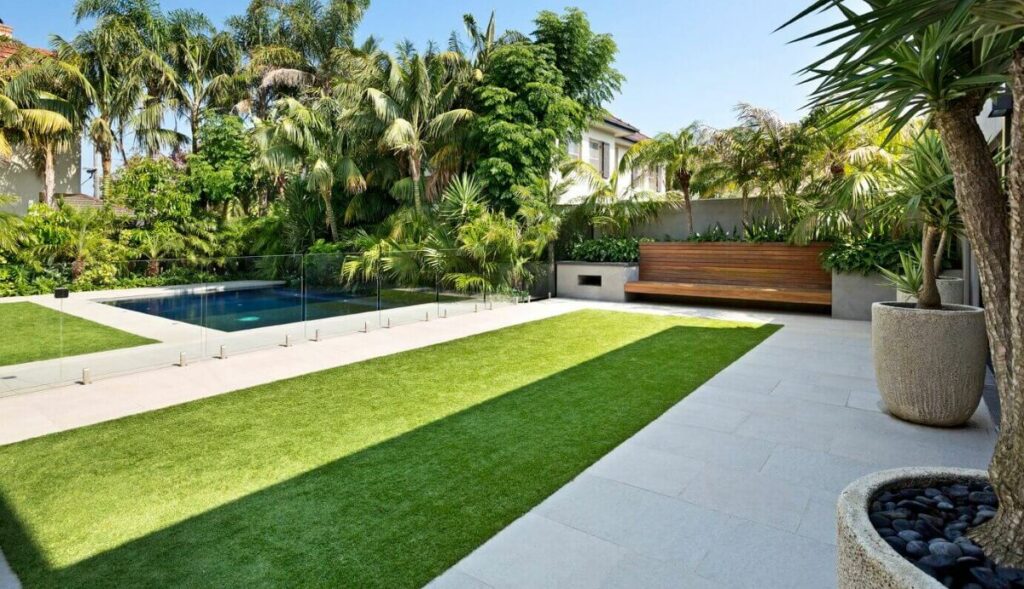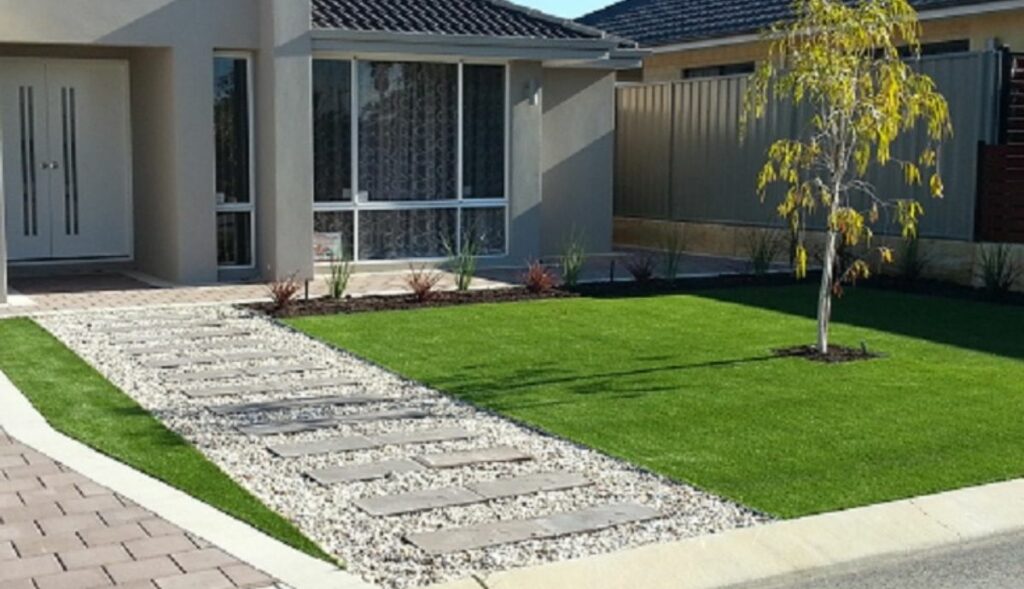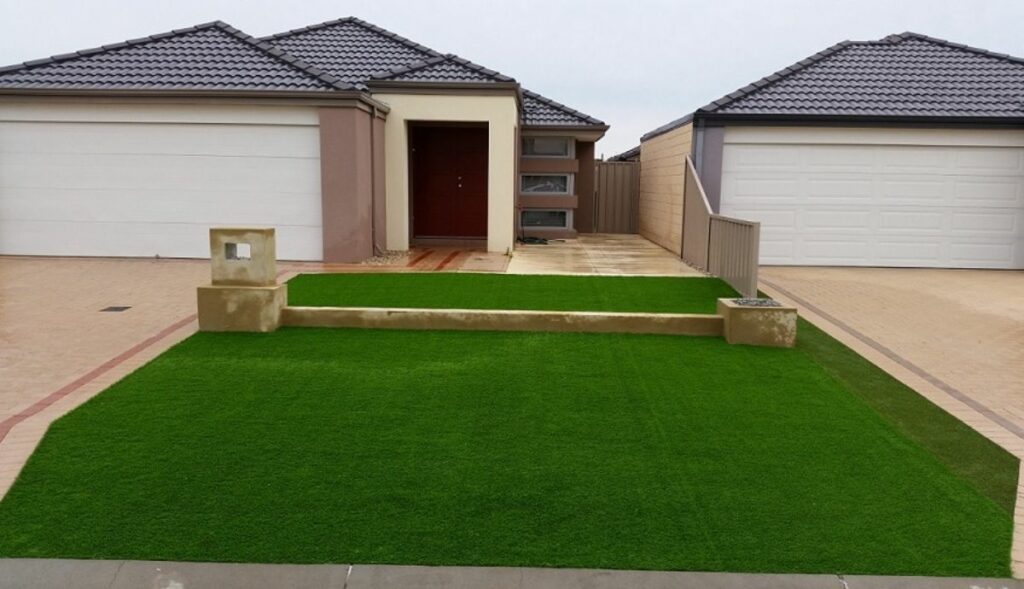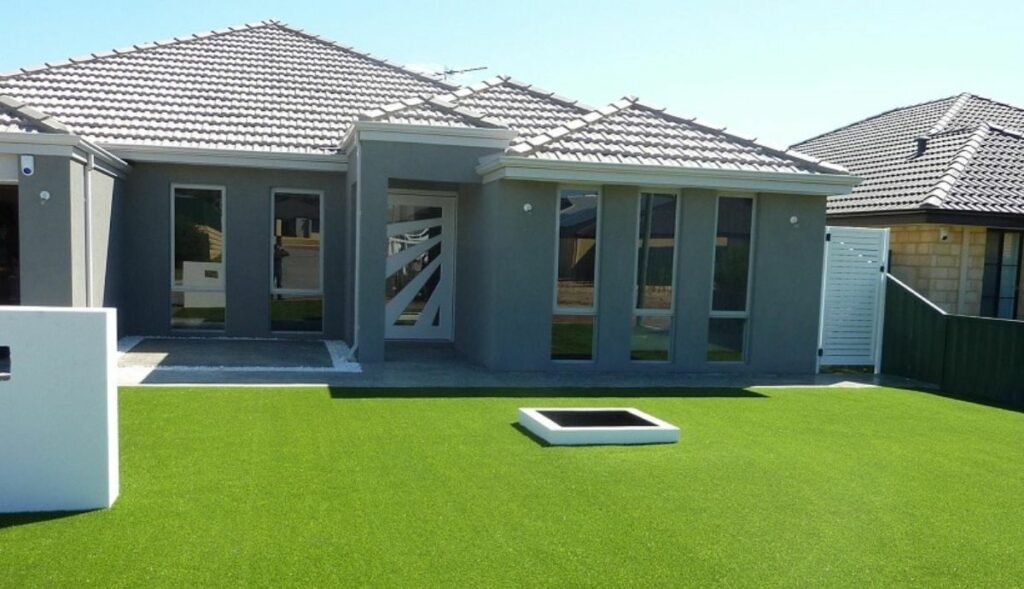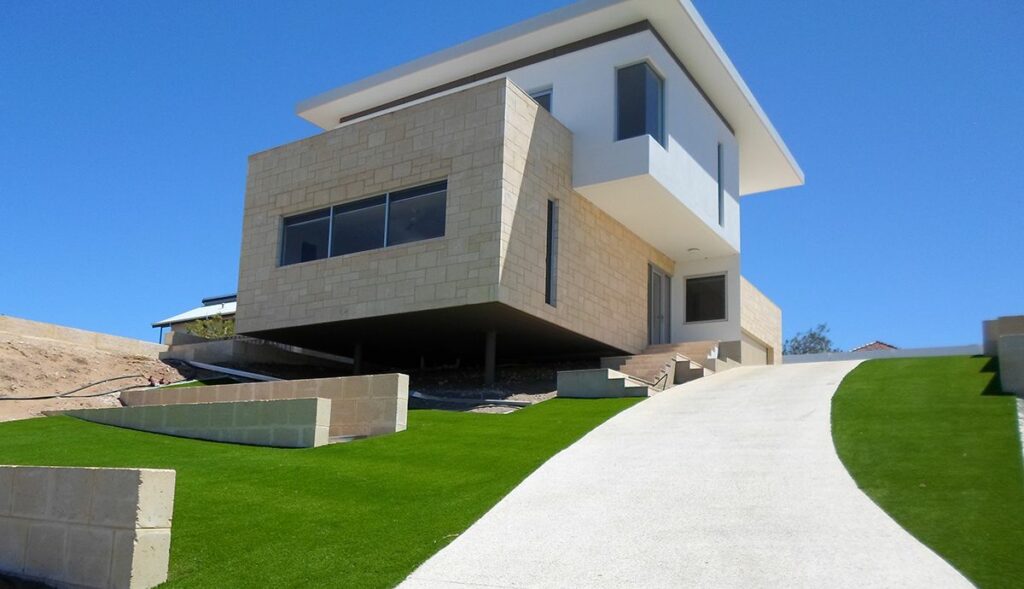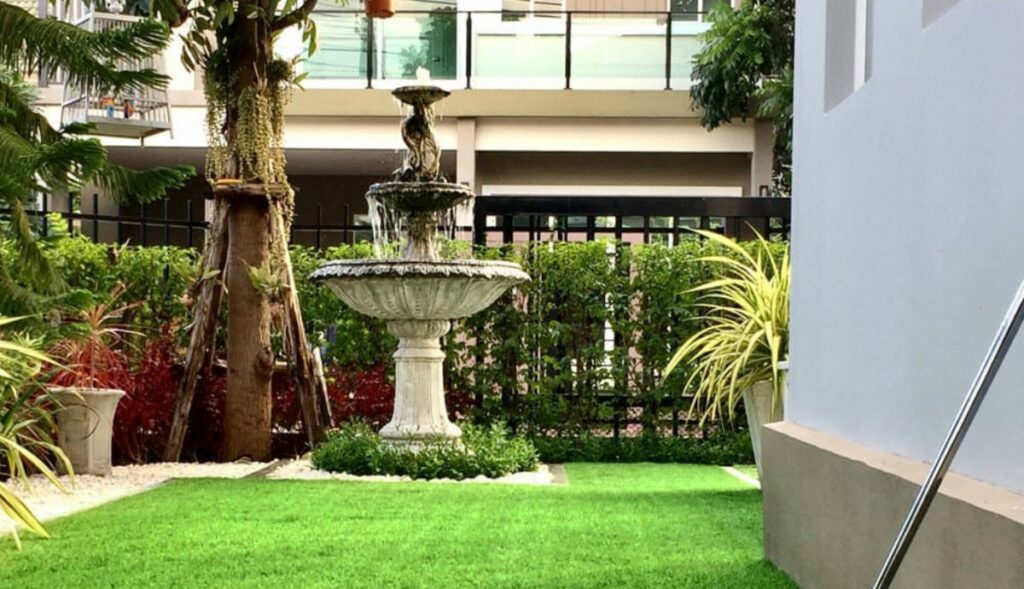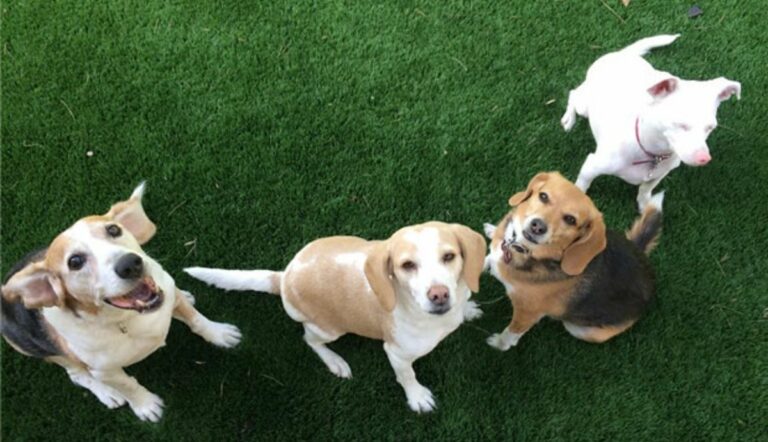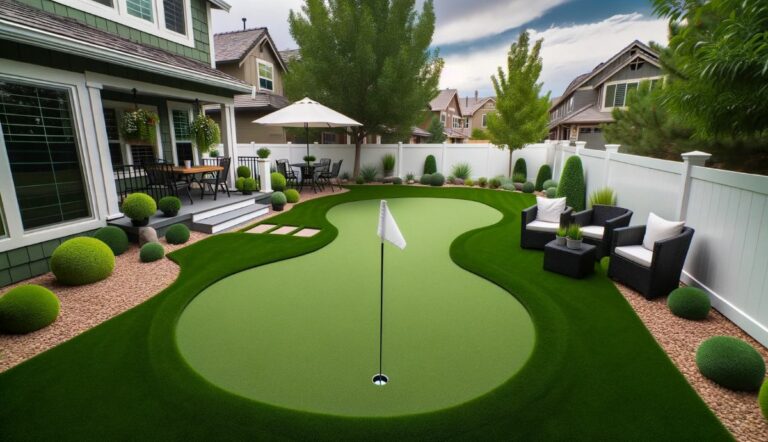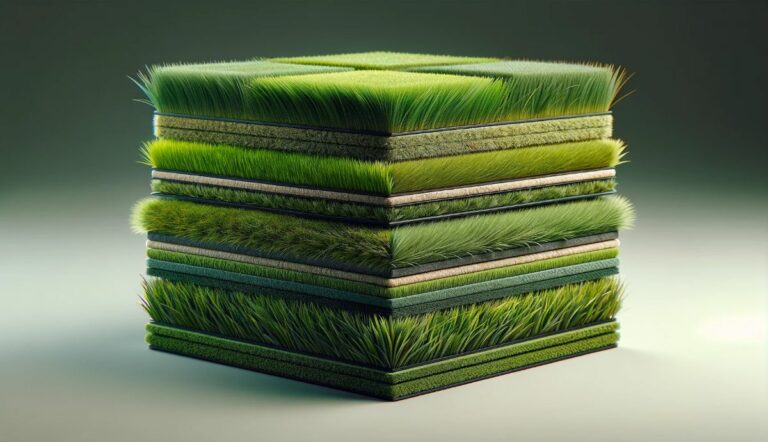A Comprehensive Guide on Choosing the Best Artificial Grass for Dogs

Are you tired of mowing the lawn but do not want to give up the greenery around your yard? There is another option! For dog owners, artificial grass is an excellent option for creating a pet-friendly environment without the neverending maintenance that comes with traditional lawns. We’ll explore how to choose the best artificial grass for your dog, considering various factors to ensure their happiness and safety while benefiting from the various benefits of artificial grass.
- Cleanliness: Easy to clean and maintain.
- Safety: Free from pests and harmful chemicals.
- Low Maintenance: No mowing or watering is required.
Contact an AI Turf partner today for the best advice and selection of Dog-Friendly Artificial Turf varieties. Or keep reading for more info on selecting the right artificial turf for your dog.
We will look at:
- Understanding the Needs of Your Dog
- Safety and Health Considerations
- Types of Artificial Grass Materials
- Importance of Underlays for Dog-Friendly Artificial Grass
- Infill Options and Their Impact
- Maintenance and Cleaning Tips
- Installation Tips for a Dog-Friendly Yard
- Customer Grass Selection Examples
- Grass Variety Recommendations for Dogs
- Selecting the right installer
- FAQ
Understanding the Needs of Your Dog
Choosing the right artificial grass for your canine companion involves considering their unique behavior and activity level. Dogs, being diverse in their habits and sizes, require a turf that matches their lifestyle while offering comfort and durability. Here are key factors to keep in mind:
- Activity Level: Active and larger dogs need robust grass that can endure energetic play and frequent running. A sturdier turf will resist wear and tear from lively activities.
- Behavioral Habits: Does your dog enjoy digging or lounging in the sun? Selecting a grass type that withstands digging and provides a comfortable resting area is essential.
- Comfort and Safety: The turf should be gentle on your dog’s paws and skin. Opt for a softer surface if your dog spends a lot of time on the grass to prevent abrasions.
- Health Considerations: Dogs with allergies or sensitivities need hypoallergenic and antimicrobial turf to reduce the risk of irritation.
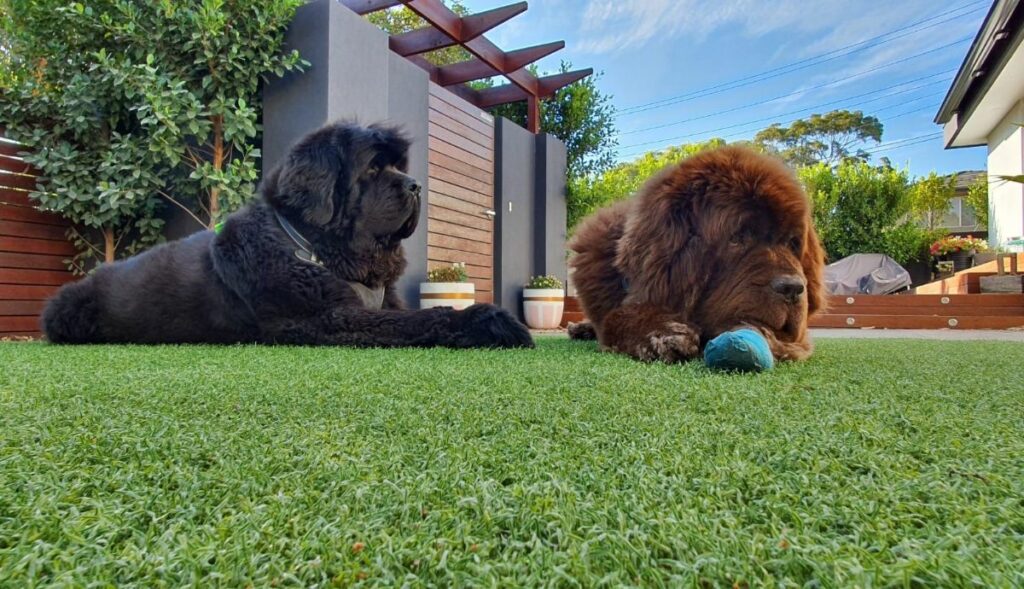
Safety and Health Considerations
When selecting artificial grass for your dog, it’s crucial to consider aspects that ensure their safety and health. Here are key considerations:
Non-Toxic Materials:
- Choose grass made from non-toxic materials to prevent health risks if your dog chews or ingests grass blades.
- Ensure the grass does not contain lead or other harmful chemicals, which can be detrimental to your pet’s health.
Heat Resistance:
- Some artificial grass can get quite hot in direct sunlight, which may be uncomfortable or even harmful to your dog.
- Look for grass with heat-resistant properties or cooling technologies to keep the surface temperature lower.
Softness and Texture:
- The texture of the grass should be soft enough to be gentle on your dog’s paws and skin to prevent injuries during play.
- Avoid overly abrasive surfaces that can cause discomfort or irritation to your pet.
Urine Resistance and Odor Control:
- Artificial grass for dogs should be resistant to urine to prevent long-term damage or odor buildup.
- Some grass types come with built-in odor control features or are designed to work well with deodorizing infills.
Allergen-Free:
- Unlike natural grass, artificial turf does not produce pollen or harbor allergens that can cause reactions in sensitive dogs.
- This makes it a good choice for pets with allergies or sensitivities.
Durability Against Digging:
- If your dog is prone to digging, choose a more durable turf that can withstand this behavior without getting easily damaged.
By considering these safety and health aspects, you can create a comfortable, enjoyable, and safe outdoor environment for your dog.

Selecting the Artificial Grass Materials for Your Dog
Selecting the best artificial grass for dogs involves understanding the different material types and their characteristics. Each material offers unique benefits and potential drawbacks, especially when considering a dog’s comfort and safety.
Nylon Turf:
Advantages:
- Exceptional durability, ideal for active or larger dogs.
- Retains its upright position and shape under heavy usage.
- Resistant to wear and tear, making it suitable for high-traffic pet areas.
Disadvantages:
- Higher cost compared to other types.
- Can feel less soft and less natural than other materials.
- Tends to retain more heat, potentially getting hot in direct sunlight, which can be uncomfortable for pets.
Polyethylene Turf:
Advantages:
- Balances softness and resilience, providing a comfortable surface for dogs.
- More natural appearance with better fade resistance.
- Generally cooler underfoot compared to nylon, making it a better choice in sunny areas.
Disadvantages:
- While durable, it may not withstand extreme rough play as well as nylon.
- Slightly less resilient to continuous heavy traffic.
Polypropylene Turf:
Advantages:
- Most cost-effective option, suitable for pet owners on a budget.
- Lighter and easier to install.
- Works well in shaded or low-traffic areas where heat retention is less of an issue.
Disadvantages:
- Least durable of the three, prone to matting and wear.
- Flattens more easily, requiring regular maintenance to keep its shape.
- Heats up quicker than other types in direct sunlight, which can be uncomfortable for pets during hot days.
When considering these materials, it’s important to factor in your specific climate and how the grass will react to sunlight exposure. In areas with intense sun, materials that retain less heat, like polyethylene, may be preferable to ensure your dog’s comfort. Additionally, consider your dog’s behavior and the intended use of the grass area to make the best choice for your furry friend.
Importance of Underlays for Dog-Friendly Artificial Grass
Underlays play a crucial role in enhancing the functionality and comfort of artificial grass, especially in areas used by dogs. Here’s why choosing the right underlay is essential:
Cushioning and Comfort:
- Underlays provide a soft, cushioned layer beneath the grass, which is particularly beneficial for dogs. This added padding can make the surface more comfortable for play and relaxation.
- It’s especially important for older dogs or those with joint issues, as the extra cushioning helps to reduce strain on their joints.
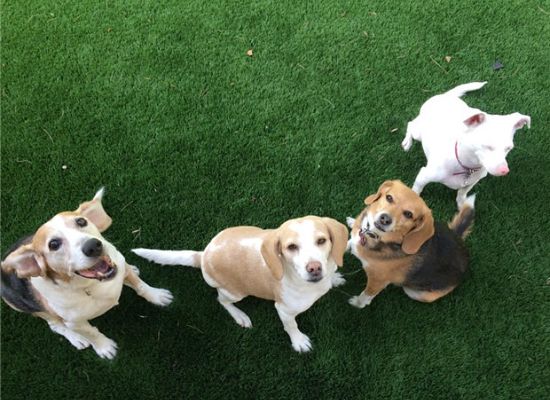
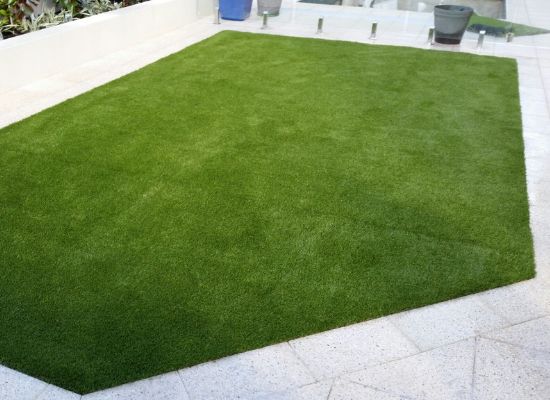
Improved Drainage:
- A good quality underlay can significantly improve the drainage capabilities of artificial grass. This is vital in areas used by dogs to ensure quick and efficient drainage of urine and rainwater.
- Proper drainage keeps the surface dry and hygienic, reducing the risk of puddles that can lead to muddy paws or breeding grounds for bacteria.
Protection Against Wear and Tear:
- Underlays act as a barrier, protecting the grass from the soil underneath and extending its lifespan. This is particularly beneficial in areas with high dog activity, where the turf might otherwise wear out more quickly.
- It helps maintain the integrity of the turf, preventing it from getting compacted or damaged due to continuous use.
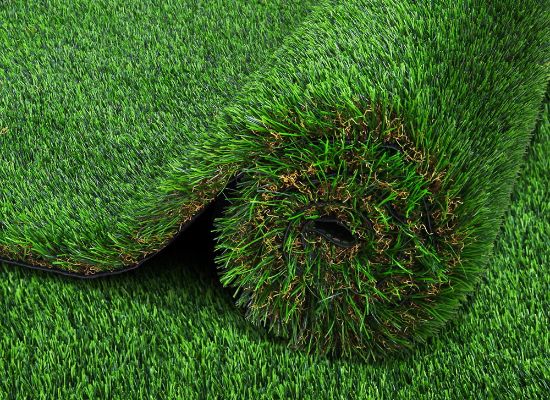
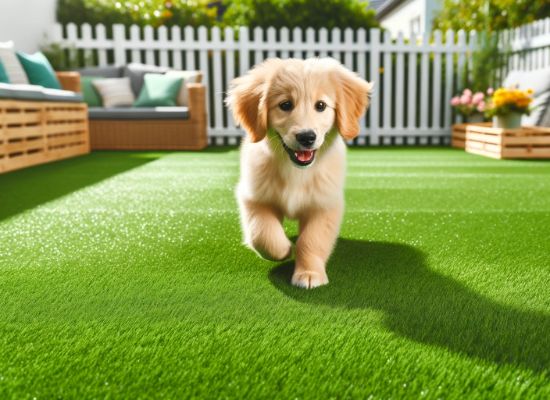
Safety and Health:
- Using underlays can prevent dogs from digging through the turf and reaching potentially harmful materials underneath.
- Non-toxic and antimicrobial underlays are available, which can further promote a healthy environment for your pets.
Underlay Material Types for Dog-Friendly Artificial Grass:
Choosing the right underlay for your artificial grass, especially in areas used by dogs, is crucial for comfort, safety, and maintenance. Here’s a closer look at different types of underlays:
Foam Padding:
Suitability: Ideal for areas where dogs play or rest. It’s also great for homes with young children or dogs with joint issues.
Pros:
- Excellent cushioning provides a soft and comfortable surface.
- Lightweight and easy to install.
- Offers some level of insulation against heat and cold.
Cons:
- Can be less durable than other underlays.
- May not provide sufficient drainage compared to other options.
Rubberized Underlays:
Suitability: Best for high-activity areas like dog runs or yards where dogs play vigorously.
Pros:
- Durable and long-lasting, can withstand heavy use.
- Good shock absorption protects dogs’ joints during active play.
- Often made from recycled materials, making it an eco-friendly option.
Cons:
- Heavier and can be more challenging to install.
- Typically more expensive than foam padding.
- In very hot climates, it can retain heat.
Geotextile Layers:
Suitability: Ideal for lawns and larger open spaces where maintaining cleanliness and appearance is a priority.
Pros:
- Enhances drainage, preventing waterlogging and odors from pet waste.
- Acts as a weed barrier, maintaining the aesthetic of the turf.
- Provides a stable base, enhancing the longevity of the artificial grass.
Cons:
- Provides less cushioning compared to foam or rubber.
- Can be more expensive than other underlay types.
- Requires professional installation for optimal performance
Selecting the appropriate underlay for your artificial grass can significantly enhance your dog’s outdoor experience. It not only adds to the longevity of the turf but also ensures a safer and more comfortable space for your furry friend.


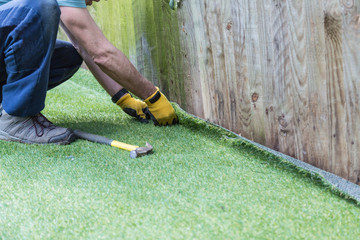
Infill Options and Their Impact
Choosing the right infill for artificial grass is particularly important in creating a dog-friendly environment. Here’s an overview of various infill options and how they impact the functionality and comfort of the turf for dogs:
Crumb Rubber Infill:
- Advantages: Durable and provides good support for the grass blades.
- Impact on Dogs: It can get hot in direct sunlight, which might be uncomfortable for dogs. There’s also a potential concern about dogs ingesting small particles.
Silica Sand Infill:
- Advantages: Offers stability to the grass and has a natural feel.
- Impact on Dogs: Cooler than crumb rubber but can be abrasive if dogs fall or slide on the turf. Also, it might clump when wet, affecting drainage.
Organic Options (Coconut Fibers, Zeolite):
- Advantages: Non-toxic and eco-friendly. Zeolite, in particular, is excellent for odor control, making it a popular choice for pet areas.
- Impact on Dogs: Safe if ingested and stays cooler than rubber or sand infills. Provides a more natural feel underfoot.
Durafill:
- Advantages: Less abrasive than sand, non-toxic, and antimicrobial.
- Impact on Dogs: Safe for pets, doesn’t compact, and maintains good drainage.
Hydrochill:
- Advantages: Designed to keep the turf cooler. Works by holding moisture and slowly releasing it.
- Impact on Dogs: Makes the surface cooler and more comfortable for pets in hot weather.
Putting Green Infill (Fine Sand):
- Advantages: It creates a smooth, even surface, ideal for putting greens.
- Impact on Dogs: Not the best option for play areas but can be used in low-traffic pet zones.
When selecting an infill, consider the following:
- Odor Control: Essential for areas where dogs will urinate.
- Heat Retention: Some infills retain more heat than others.
- Comfort and Safety: Softer and non-toxic infills are better for dogs.
- Drainage: Good drainage is crucial for hygiene and maintenance.
The right infill can significantly affect the overall performance of the artificial grass, especially in accommodating the needs and safety of your dogs. Therefore, it’s important to choose an infill that aligns with your specific requirements and the well-being of your pet.
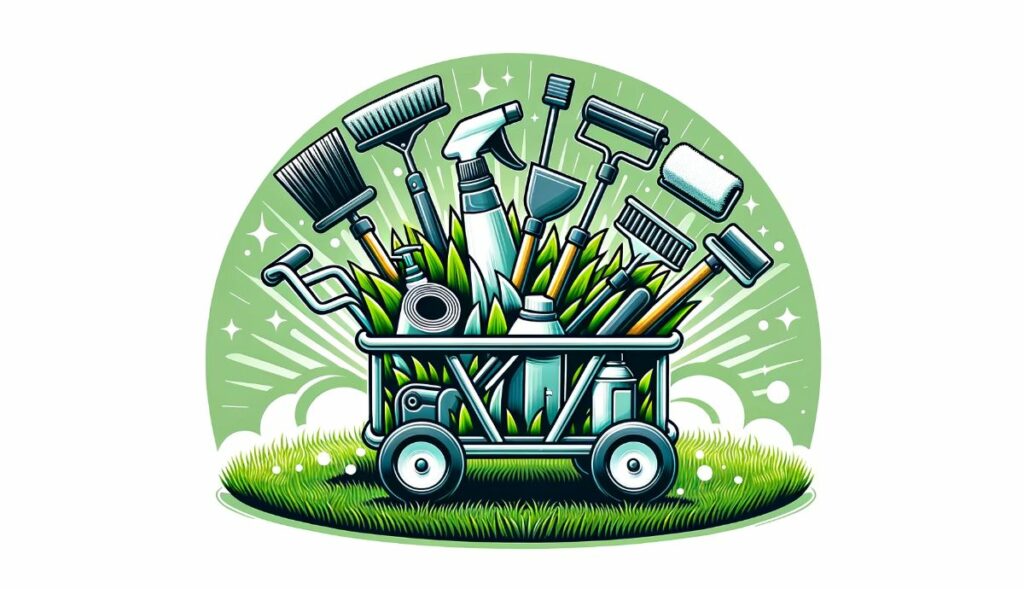
Maintenance and Cleaning Tips
Maintaining and cleaning artificial grass is essential to ensure a hygienic and enjoyable space for your dog. Here are practical tips to keep your artificial turf in top condition:
Regular Cleaning:
- Brushing: Regularly brush the grass to prevent matting and keep the fibers standing upright. This also helps to distribute infill evenly.
- Rinsing: Hose down the grass occasionally to remove dust and minor stains, keeping the turf fresh and clean.
Managing Pet Waste:
- Solid Waste: Remove solid waste promptly. Most artificial grass is resilient enough to handle a gentle hosing afterward to remove any residue.
- Urine: Although artificial grass typically drains well, rinsing areas where your dog urinates helps prevent odor buildup and maintains hygiene.
Dealing with Stains and Spills:
- Immediate Action: Address spills and stains as soon as they occur. Most spills can be cleaned with water and mild detergent.
- Avoid Harsh Chemicals: Use only non-toxic cleaners to avoid damaging the grass and ensure safety for your pet.
Preventing and Treating Odors:
- Regular Maintenance: Regular cleaning is key to preventing odors.
- Specialized Products: There are pet-friendly turf deodorizers available that can be applied to neutralize odors without harming the grass or your pet.
Seasonal Care:
- Summer: In hot weather, occasional sprinkling can help cool down the grass, making it more comfortable for your pet.
- Winter: During colder months, artificial grass requires less maintenance but should be checked for ice or snow buildup, which should be gently removed.
Long-term Care:
- Professional Inspection: Annually, consider a professional inspection to ensure the turf is in optimal condition, especially in high-traffic pet areas.
- Infill Replenishment: Over time, infill may need to be replenished to maintain the grass’s resilience and drainage efficiency.
By adhering to these maintenance and cleaning tips, you can extend the life of your artificial grass and provide a clean, safe, and enjoyable environment for your dog. Regular upkeep is the key to preserving the aesthetic and functional qualities of your turf.
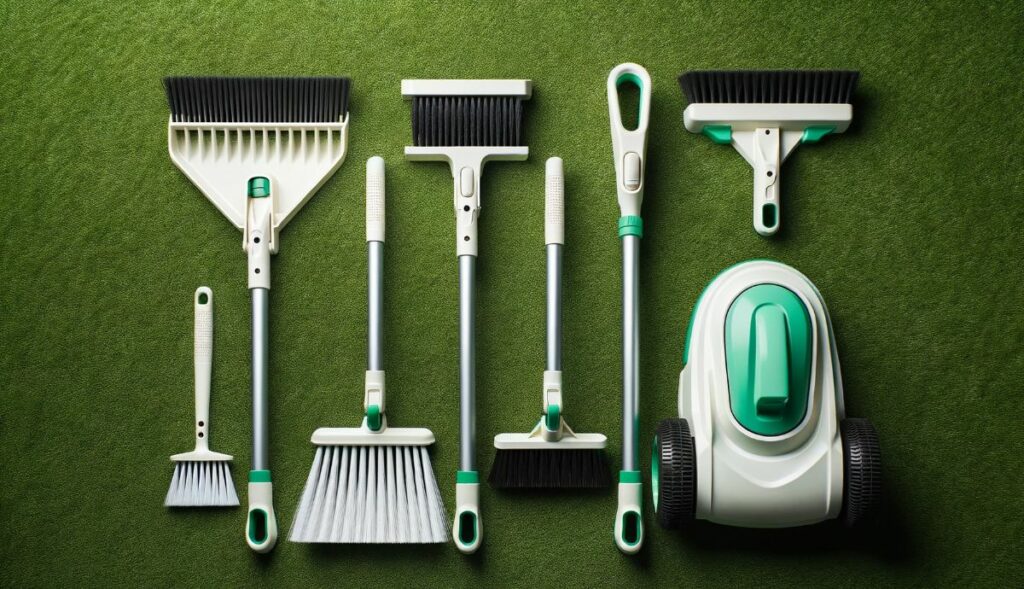
Installation Tips for a Dog-Friendly Yard
Proper installation of artificial grass is crucial for creating a dog-friendly yard. Whether you opt for professional installation or a DIY approach, here are some tips to ensure a safe and enjoyable space for your dog:
- Choosing the Right Grass: Select a turf that suits your dog’s needs in terms of durability, texture, and safety. Consider factors like your dog’s size, activity level, and the climate of your region.
- Preparing the Base: The foundation is key to a successful installation. Ensure proper ground leveling and compacting of the base material, usually crushed rock or gravel, for adequate drainage and stability.
- Ensuring Proper Drainage: Install a drainage system that can effectively handle both rainwater and pet urine. This is essential to prevent pooling and maintain a clean, odor-free yard.
- Securing the Turf: Properly secure the edges and seams of the turf to prevent lifting or shifting. This is particularly important in areas where dogs may run or play vigorously.
- Choosing the Right Infill: Select an infill that’s suitable for pets, like antimicrobial or organic options, to aid in odor control and provide additional cushioning.
- Considering Underlay: If needed, add a padded underlay for extra comfort, especially for older dogs or those with joint issues.
- Professional Installation vs. DIY: While DIY installation can be more cost-effective, professional installation ensures that all aspects, from base preparation to final laying, are handled correctly. If you choose to DIY, follow manufacturer guidelines closely and consider consulting with experts for tips and advice.
- Post-Installation Care: After installation, brush and rinse the turf to remove any loose debris and ensure the infill is evenly distributed. Regularly inspect the turf for any signs of wear or damage, especially in areas frequently used by your dog.
By paying attention to these installation tips, you can create a dog-friendly yard with artificial grass that looks great, functions well, and provides a safe and happy environment for your furry companion.
Client Scenarios of Great Dog-Friendly Artificial Turf Choices
Phoenix, Arizona: John Martinez’s Choice
In Phoenix, Arizona, known for its relentless sun, John Martinez, a homeowner and dog owner, was looking to create a backyard oasis. He needed a solution to provide comfort and safety for his family, including his playful dog, in the extreme heat.
John, with guidance from an Ai Turf partner, chose polyethylene turf for its UV resistance and lower heat absorption, essential in Phoenix’s climate. To further combat the heat, he selected Hydrochill infill, known for its cooling properties, combined with silica sand for stability. This combination significantly reduced the surface temperature, making it comfortable even on the hottest days.
A cushioned, breathable underlay was installed in the children’s play area for added comfort and safety. This underlay choice also aided inefficient drainage, a key aspect for managing pet waste and rainwater. John opted for a medium pile height of 1.5 to 2 inches, providing a natural feel and ensuring ease of maintenance under the Arizona sun.
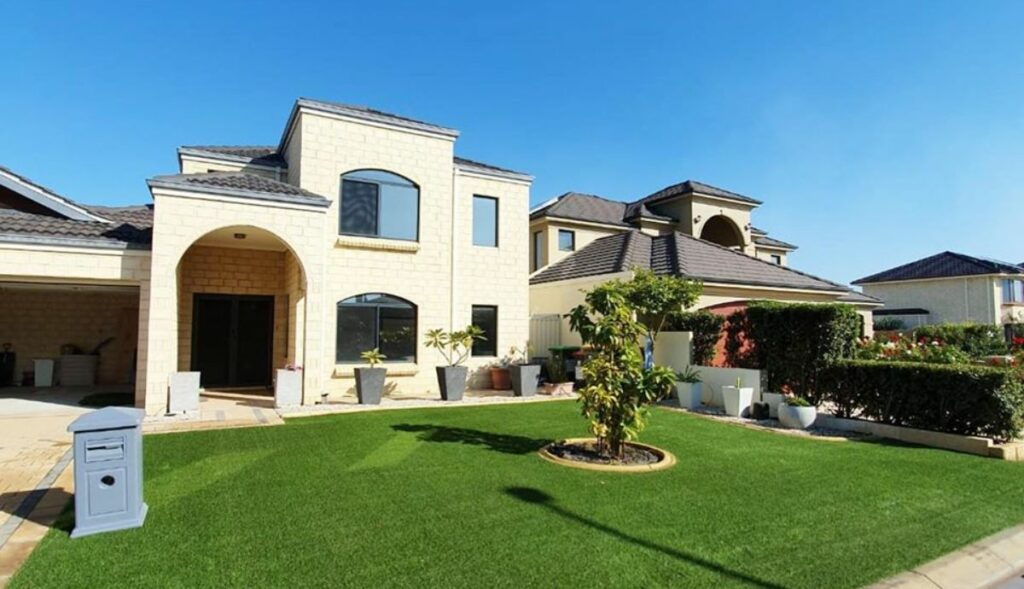
Denver, Colorado: Emily Robinson’s Pet-Friendly Lawn
In the chilly climate of Denver, Colorado, Emily Robinson sought an artificial grass solution for her residential lawn that would endure the cold winters while providing a safe and enjoyable environment for her two Golden Retrievers.
Emily, with recommendations from an Ai Turf expert, selected nylon turf for its unmatched durability against the cold and ability to resist snow and moisture. Nylon’s robustness was perfect for her dogs’ high-energy play and ensured the lawn’s structural integrity during harsh winters.
For infill, she chose Zeolite, known for its excellent odor control, vital for managing pet waste. Along with this, a layer of crumb rubber provided additional freeze resistance and maintained turf stability. To maximize comfort and insulation against the cold ground, Emily invested in a high-density foam underlay.
Given the frequent snowfall in Denver, Emily opted for a shorter pile height of around 1 inch. This choice made snow removal easier and kept the turf looking tidy and well-maintained throughout the winter, ensuring a pleasant outdoor space for her pets all year round.
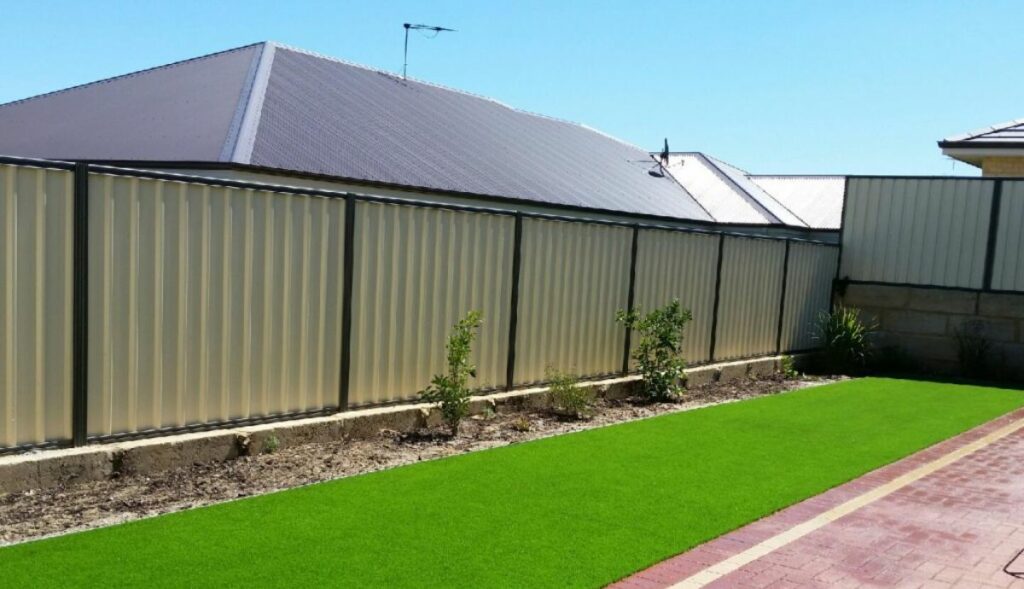
Some of the Best Dog-Friendly Artificial Grass Varieties We Recommend
Synlawn’s PET PLATINUM
Description: Designed for areas with high foot traffic and pet usage, offering exceptional durability and superior drainage.
Features:
- Sanitized® Antimicrobial, DualChill™ IR Reflective, StatBlock™ Anti-Static
- Super Yarn™ technology
- Unmatched Lifetime Warranty
- Optimal Drainage > 1,000″ p/hr
- Finished Pile Height: 1 1/2”, Finished Pile Weight: 80 oz
Pregra’s Pet Artificial Turf
Description: Ideal for dog runs and play areas, offering easy maintenance and natural feel under paws.
Features:
- 48 oz. Face Weight, 74 oz. Total Weight per square yard
- Eco Friendly, Soy-based, water-permeable backing
- Drains >30 inches per hour
- Low maintenance and all-weather rated
- 10-year manufacturer’s warranty
- Made in the USA
Foreverlawn’s K9Grass Classic
Description: Specially designed for dogs, perfect for handling pet waste and high-traffic pet areas.
Features:
- Flow-Through Backing™
- AlphaSan® antimicrobial technology
- Yarn Type: Polyethylene monofilament and textured nylon monofilament
- Yarn Color: Summer Green and Turf Green
- Blade Height: 7/8”
- Face Weight: 65 ounces
Synlawn’s SYNAUGUSTINE 547
Description: Combines eco-friendliness with durability, making it an excellent choice for pet-friendly lawns.
Features:
- USDA Certified Bio-Preferred
- Super Yarn™ Technology, EnviroLoc+™
- Unmatched Lifetime Warranty
- ASTM E108 Class A Fire Rating
- Sanitized® Antimicrobial, DualChill™ IR Reflective, StatBlock™ Anti-Static
- Optimal Drainage > 800″ p/hr
Installartificial’s Baby Touch
Description: This artificial grass provides the best feeling and survives more traffic. People with puppies would choose it often. This grass is easier to clean and brush due to its uniform surface. It is cooler than other materials.
Features:
- Feels soft day and night.
- Provides a great cushion.
- Makes a cozy patio.
- Optimal Drainage > 800″ p/hr
- Blade Height: 1.7”
- Face Weight: 55 ounces
Selecting the Right Installer for Your Dog-Friendly Artificial Lawn
When installing an artificial lawn for your dog, it’s essential to choose the right professional. Here are the key factors to consider:
- Pet-Friendly Installation Experience: Opt for an installer with experience in dog-friendly lawns, familiar with the specific requirements like drainage and suitable materials.
- Credentials and Reviews: Check their qualifications and read reviews, particularly from clients with pet-friendly installations.
- Material Knowledge: Ensure they are knowledgeable about various artificial grass types, underlays, and infills suitable for dogs.
- Drainage Expertise: The installer should understand how to create effective drainage systems for handling pet waste and rainwater.
- Workmanship Quality: Quality workmanship ensures a durable and safe lawn for your pet. Assess their attention to detail and overall installation quality.
FAQ: Artificial Grass for Dogs
Is artificial grass safe for dogs?
Yes, high-quality artificial grass is safe for dogs. It’s non-toxic and free from harmful chemicals, making it a safe surface for pets to play on.
Can dogs damage artificial grass?
Generally, artificial grass is highly durable and designed to withstand pet activities. However, the extent of durability depends on the quality of the grass and installation.
How do I clean and maintain artificial grass with a dog?
Regularly brush the grass to prevent matting, rinse off urine with water, and remove solid waste promptly. Use pet-friendly cleaners for any stains.
Does artificial grass get too hot for dogs?
Some artificial grass can get hot in direct sunlight. Opt for grass with heat-resistant properties or use a Hydrochill infill to keep the surface cooler.
What’s the best type of artificial grass for dogs?
Look for durable types like nylon or polyethylene, which are also soft and comfortable. The choice also depends on your dog’s size and activity level.
How does artificial grass affect drainage and odor control with pets?
Good quality artificial grass comes with efficient drainage systems to handle urine. For odor control, use infills like Zeolite that neutralize odors.
Can I install artificial grass by myself if I have pets?
DIY installation is possible, but professional installation is recommended to ensure proper drainage and durability, especially in areas used by pets.
What should I consider when choosing infill for a dog-friendly lawn?
Choose non-toxic infills like organic options or sand for comfort and safety. Avoid crumb rubber as it can heat up and may not be suitable for all dogs.
